There are few places to rival the beauty of southern England, especially on a sunny day.
We had visited Oxford a number of times, but for whatever reason, we had never seen Christ Church Cathedral and it was on my list to photograph. (I’ve now done 34 of the 42 Anglican Cathedrals and hope to finish that project in 2021).
Though our ultimate destination was the Cathedral, we took the opportunity to explore the adjacent College, as urged by the Christ Church website:
“Christ Church is an essential element in any visit to Oxford. Two of its famous landmarks, Tom Tower, by Christopher Wren, and Oxford’s Cathedral spire, define the city’s celebrated skyline and mark Christ Church as a unique dual foundation: one of Oxford University’s largest Colleges and the Cathedral Church for the Diocese of Oxford.”
Named after its bell, Great Tom. Tom Tower sits over Tom Gate, the main entrance of Christ Church, Oxford, which leads into Tom Quad (do you notice a trend here)? The famous landmark is a square tower with an octagonal lantern and facetted ogee (s-shaped) dome. Designed by Christopher Wren of St. Paul’s Cathedral fame, it was built between 1681 and 82. The gatehouse structure had been left roofless since 1529 following Cardinal Wolsey’s falling out with Henry VIII, and though long out of fashion, Wren made a case for completing the tower in the Late Gothic style to keep it consistent with what might have been designed had construction not been interrupted. The result is a faultless blend, I think.
The bell itself, Great Tom, is the loudest bell in Oxford and has a storied history all its own. Originally named “Mary”, it was moved to St Frideswide’s church (the precursor to Christ Church) following the Dissolution of the Monasteries and at some point was renamed “Tom”, reasons not disclosed. The bell had been problematic since its original casting and has been recast several times, increasing its weight from the original two tons to over six. The final version was hung in 1680.
Except for one night in 2002 when some prankster students “lagged the clapper” (enclosed it in material to muffle the sound), Great Tom has sounded 101 times every night since the second world war. The number signifies the 100 original scholars of the college plus one (added in 1663). With typical British eccentricity, the ringing occurs at 21:05 current UK time, to correspond to what used to be known as “Oxford time”. There’s nothing like a Brit for stubborn individualism. Noon in Oxford occurs five minutes later than noon in Greenwich. Right, then.
In former times the ringing of the bell was performed at midnight, giving due warning of the closing of all college gates throughout Oxford. It seems that ringing a six-ton bell takes quite a bit of time. Twenty minutes, in fact. Thus it came to pass that Christ Church gates, unlike those of other colleges, did not close until 12:20. In later years, having twenty minutes of cacophony at midnight proved unpopular with the locals (no doubt frustrated parents lulling little darlings to sleep), so the ringing was moved back to 9:00 pm, though the closing time for the gates remained at 12:20. Although the clock itself now shows GMT/BST, Christ Church still follows Oxford time in the timings of services in the cathedral.
As adjured by the College & Cathedral’s website we took due note of the Christ Church Cathedral spire. I’ll be covering the Cathedral in a separate post, as there is plenty to see over here at the College.
Christ Church College was originally known as Cardinal College, founded by Thomas Wolsey in 1524. Wolsey was an interesting character. His credentials included being an English archbishop, statesman and a cardinal of the Catholic Church.
When Henry VIII became King of England in 1509, Wolsey became the King’s almoner, a term I had to look up; it means “chaplain or church officer who originally was in charge of distributing money to the deserving poor.” Downton Abbey fans may recognize the term from Isobel Crawley’s appointment as the hospital’s Almoner (causing no end of rivalry and ruckus with the Dowager Countess).
At first, Wolsey’s affairs went along swimmingly. By 1514 he had become the Grand Fromage in virtually all matters of state, eventually rising to Lord Chancellor, the King’s chief adviser. As such, he enjoyed great freedom, even being viewed as an alter rex or other king – an object lesson in being careful what you wish for.
In 1525, at the apex of his influence, Wolsey suppressed the Priory of St Frideswide in Oxford and founded Cardinal College on its lands, using funds from the dissolution of Wallingford Priory and other minor priories.
This was a good ten years before Henry VIII undertook the full Dissolution of the Monasteries, officially dated between 1536 and 1541. Cardinal College was just a warm-up.
The rot in Wolsey’s fortunes set in when Wolsey failed to negotiate an annulment of Henry’s marriage to Catherine of Aragon. His fall from grace was precipitous and absolute. Wolsey was stripped of his government titles and retreated to York to take up his ecclesiastical duties as Archbishop of York, a position he had long neglected during his years in government. To add insult to injury, he was subsequently recalled to London to answer to charges of treason.
This was a revenge tactic frequently employed by Henry VIII against ministers who fell out of favour, whether or not they had committed actual treason. And we think Fake News is new. Happily for Wolsey, he died on the way from natural causes, rather than suffer the beheading that was in store for him.
The portraits above hang in The Hall, which served as inspiration for the Great Hall in the Harry Potter series by JK Rowling.
Placed high on the walls, the portraits down the sides of the Hall are tipped at an angle, making them more visible to the diners at the long tables, at which meals are served three times daily.
Wolsey’s plans were on a magnificent scale, but at the time of his fall from grace in 1529, the buildings were only three-quarters complete, and so they remained for 140 years. In 1531 the college itself was suppressed; King Henry VIII was an apt pupil. It was refounded in 1532 as the eponymous King Henry VIII’s College. Funny thing, that. Wolsey’s property had been escheated (had to look that one up, too – it means transfers the real property of a person who has died without heirs to the Crown or state. Can’t be leaving land and buildings lying around unclaimed now, can we? Can anyone spell Conflict Of Interest? No, that’s not new, either.
The Hall comprises the finest surviving section of the college’s original foundation. The Renaissance magnificence hints at the scale Cardinal College might have reached had it not been for Wolsey’s fall.
In 1546, coffers swelling from the appropriation of assets hoovered up in the Dissolution of Monasteries, Henry VIII refounded the college as Christ Church as part of the reorganization of the Church of England. The partially demolished priory church became the cathedral of the recently created Diocese of Oxford. More on that later.
Of particular note is the hammer-beam ceiling. Frankly, I’d never given much thought to the engineering behind hammer-beam roofs, but I was curious. It turns out that they’re essentially a tie beam with the middle cut out. Sounds a bit alarming, doesn’t it? Traditionally timber-framed, they’re made using short beams projecting from the wall on which the rafters rest. The short beams are called hammer-beams, hence the name. No wonder they’ve been called “…the most spectacular endeavour of the English Medieval carpenter”, according to Wikipedia.
In addition to Harry Potter, Christ Church has another famous literary connection in the form of Charles Dodgson, better known as Lewis Carroll. Dodgson studied, taught and lived at Christ Church for 47 years. Henry Liddell was The Dean at Christ Church at the time when his daughter, Alice Liddell, took her debut in Dodgson/Carroll’s Alice’s Adventures in Wonderland. Apparently her face and a number of creatures from the books are shown in a window high up on the left-hand wall, fifth from the entrance, in case you’re ever visiting. I didn’t notice it at the time. The shot below is a screenshot from the brochure on the College’s website.
The window in question would be similar to the one below. You can see faces on the two outer panels of the upper sections.
After doing that research, I began to wonder if Alice Liddell was any relation to Rod Liddle who, on January 12 of this year, penned A personal message from HRH Rod Liddle for the Sunday Times, In my progressive new role, I’m stepping back from writing but keeping my salary”, an hilarious parody of the personal message from Harry and Meghan released on their SussexRoyal website. But I digress. Back to the Hall.
Dinner, consisting of a served two or three-course meal, has two sittings: Informal Hall at 6.20 pm and Formal Hall at 7.20 pm. Gowns are worn at Formal Hall and a Latin grace is said at the lectern by an undergraduate scholar and senior members dine at High Table. Prior to dinner, wine, beer, and other drinks can be purchased from the adjacent Buttery, which is somewhere around this landing outside the Hall.
I didn’t notice the Buttery when I was entering the Hall; the door must be quite unobtrusive. Described by the Oxford Dictionary as ‘a storeroom for provisions, especially ale and other alcoholic drinks; a pantry, a larder’, as well as ‘at certain universities, esp. Oxford and Cambridge: a place on university premises where students may buy food, drink, and other provisions’.
I was intrigued by the connection to Butter Beer, which makes frequent appearances in the Harry Potter Books.
But really, who is thinking about storage rooms with these fan arch ceilings beckoning?
Here is where Professor McGonagall welcomes Harry and his classmates to Hogwarts at the top of the Hall Stairs.
I had to hang around for a while to get some shots without a crowd of people in them. This is a very popular spot.
I can’t imagine a more magnificent route to take to dinner!
Floating up the stairs, eyes drawn to the ceiling.
Back outside, we continued our tour.
I love the lanterns, with their clear globes, perched delicately on the wrought iron arms.
This is the incredibly spacious Tom Quad. It is the largest college quad in Oxford, measuring 264 by 261 feet. And we had it all to ourselves for a fleeting second. You access the Hall through the dark archway under the big rectangular building over on the right.
Once outside, we took the time to admire some of the stone carvings. One can’t help feeling a bit sorry for Wolsey, in spite of his overweening ambition.
Procuring an annulment after 20+ years of marriage was no easy feat. Henry VIII was an exacting taskmaster (aka tyrant). Wolsey paid for his failure with his life.
We left the way most people come in, through the Meadow Building. It’s relatively modern, being built specifically for undergraduates in the nineteenth century when the University was shifting its emphasis to undergraduate education. It was then Oxford developed its famed tutorial system, in which one or two students discuss their work with a tutor each week, a practice that continues to this day.
The Meadow Building is in the Venetian Gothic style, made popular by John Ruskin (of the pithy sayings). A Christ Church alumni, Ruskin admired the buildings of Venice and wanted to incorporate some of their elements within contemporary architecture, as seen in the pointed shape of the windows and lancet arches. Ruskin may have proposed, an Irish architect, T. N. Deane, disposed. He was well known in Dublin for his work on the National Museum and Library.
Oxford University is quite something. Steeped in history and tradition, it’s the “Ox” of the University described as “Oxbridge”, the other being Cambridge.
Christ Church College is inextricably connected to Christ Church Cathedral, our next stop.
Thanks for joining me!
I’m sharing this post with Between Naps on the Porch.

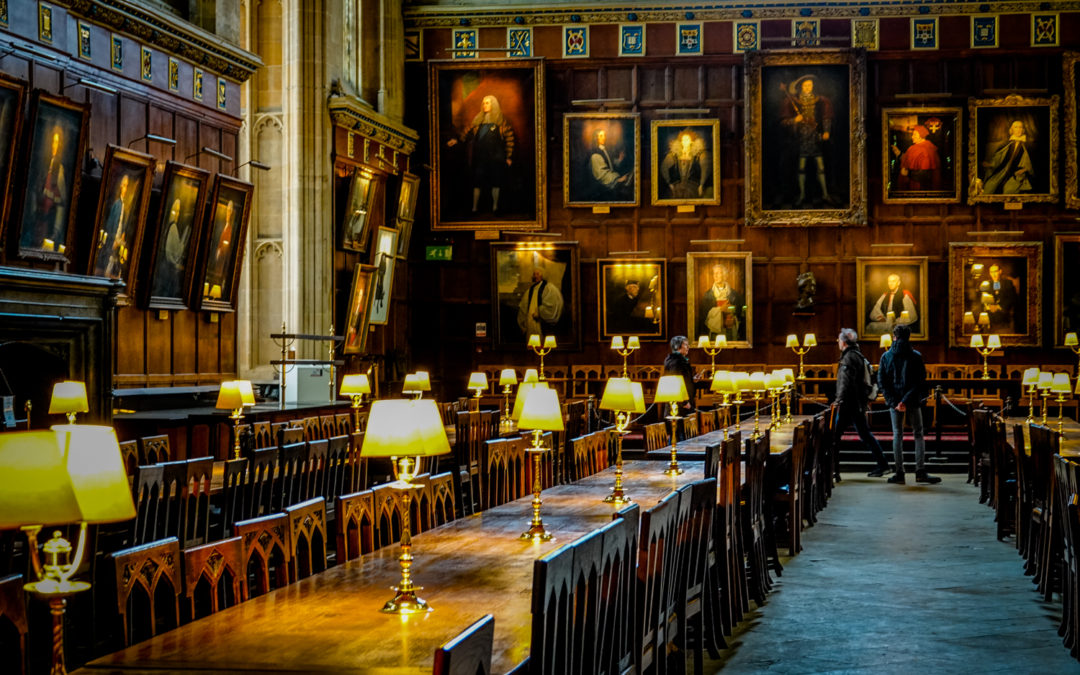

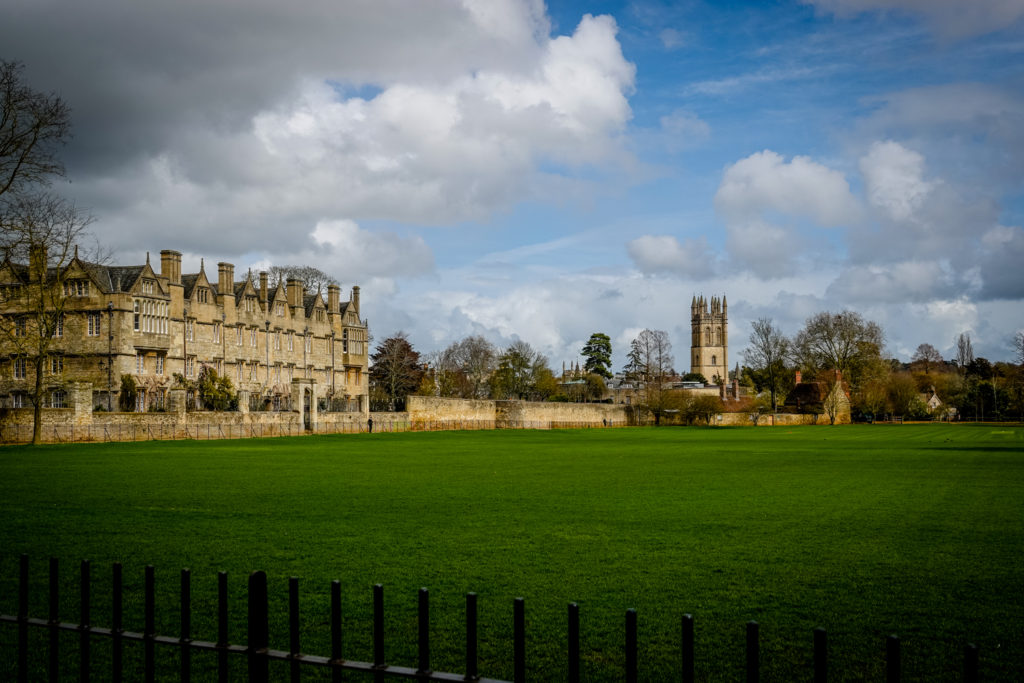
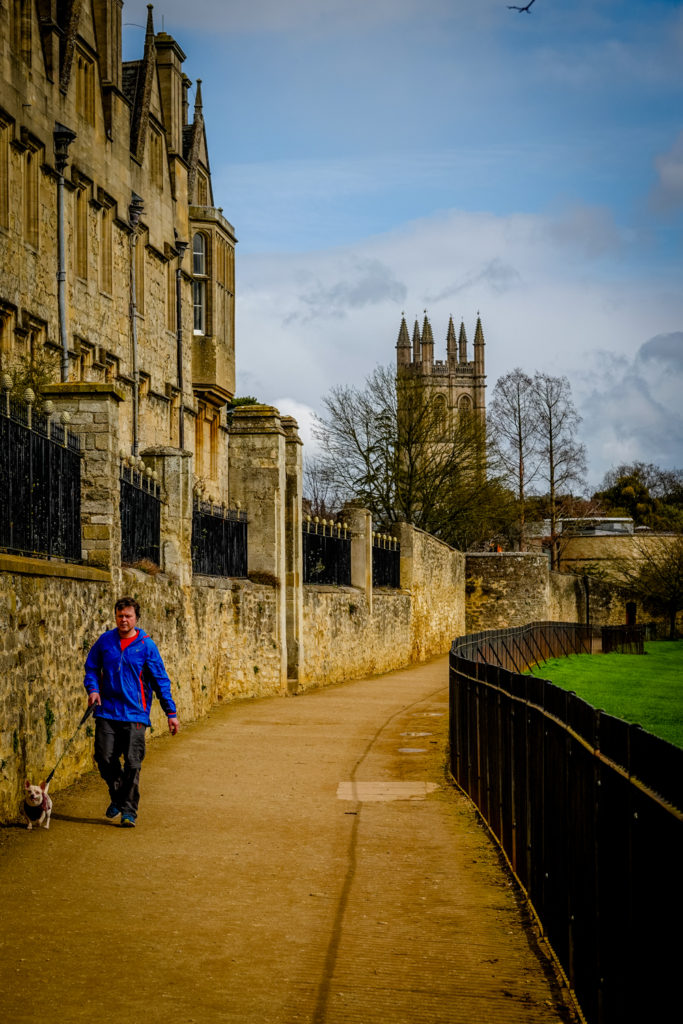











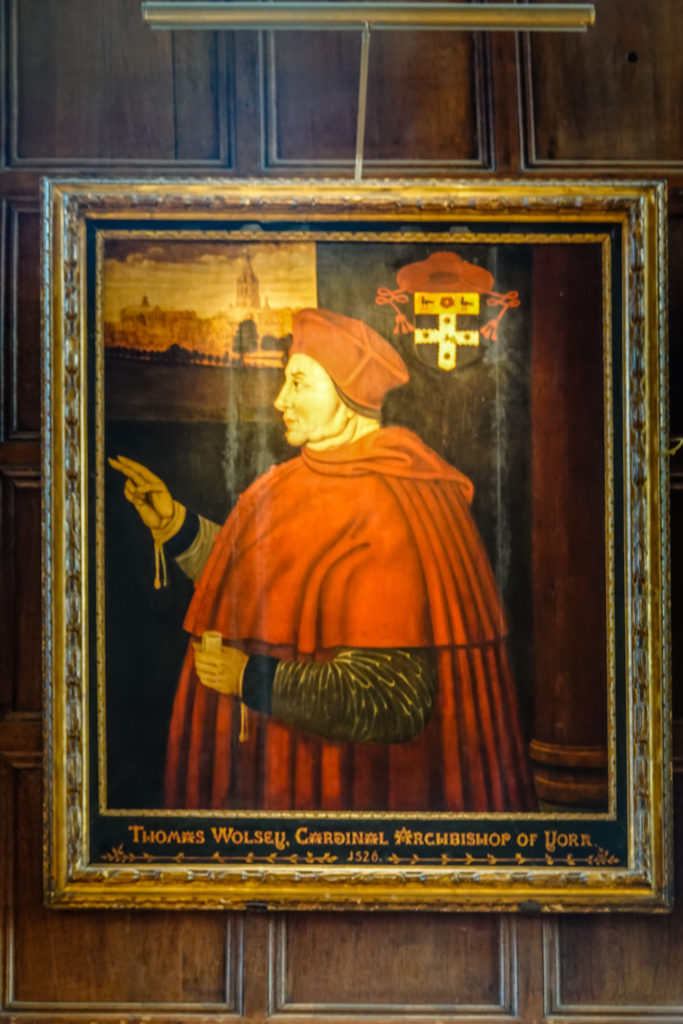














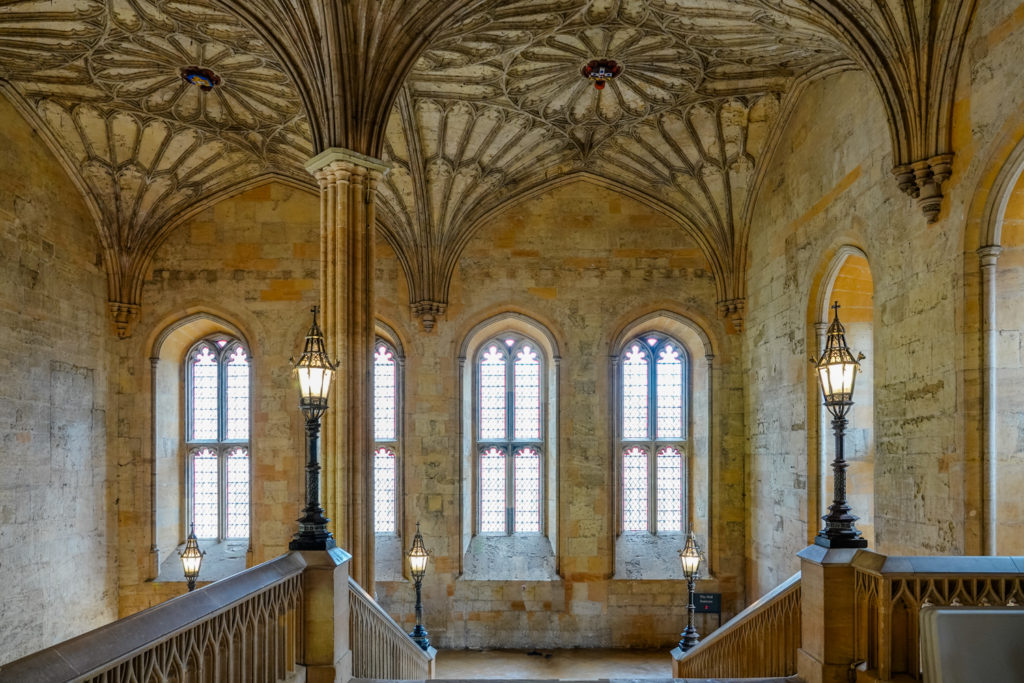

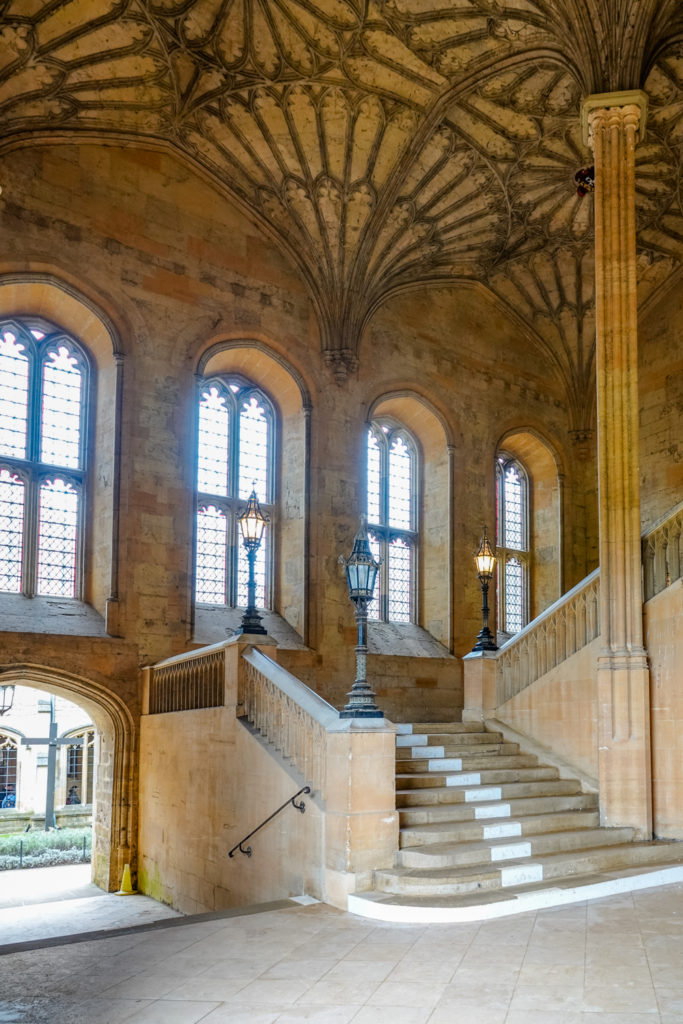
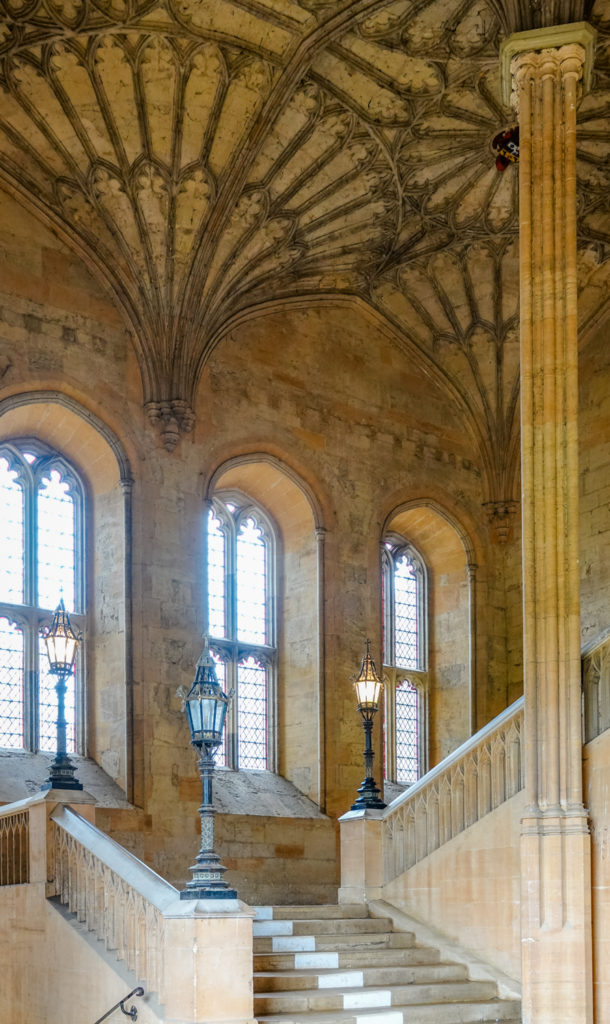

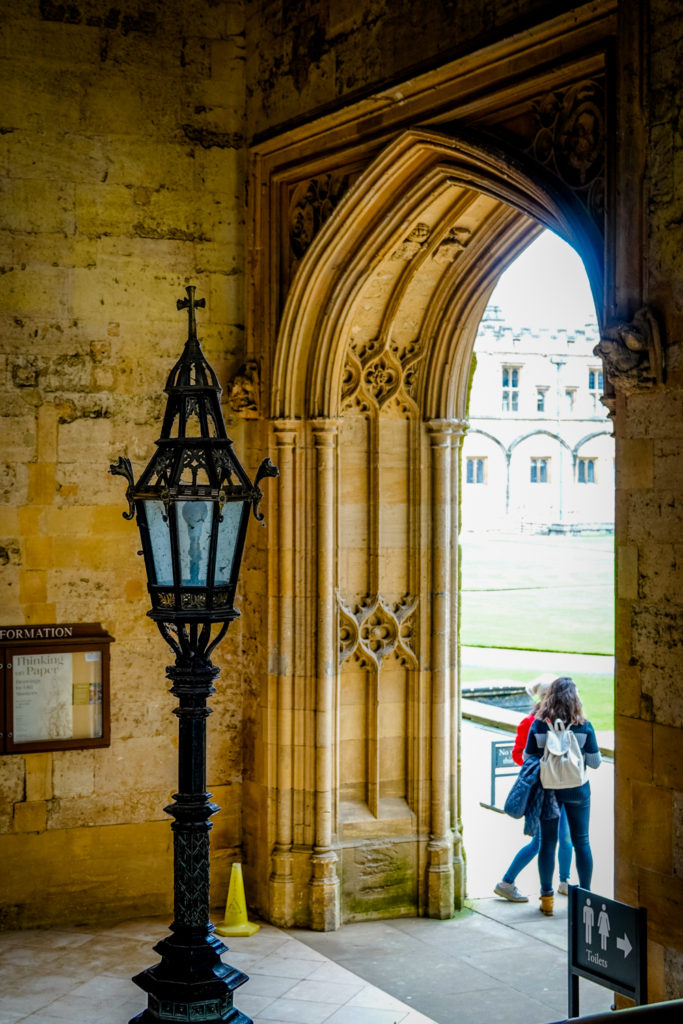







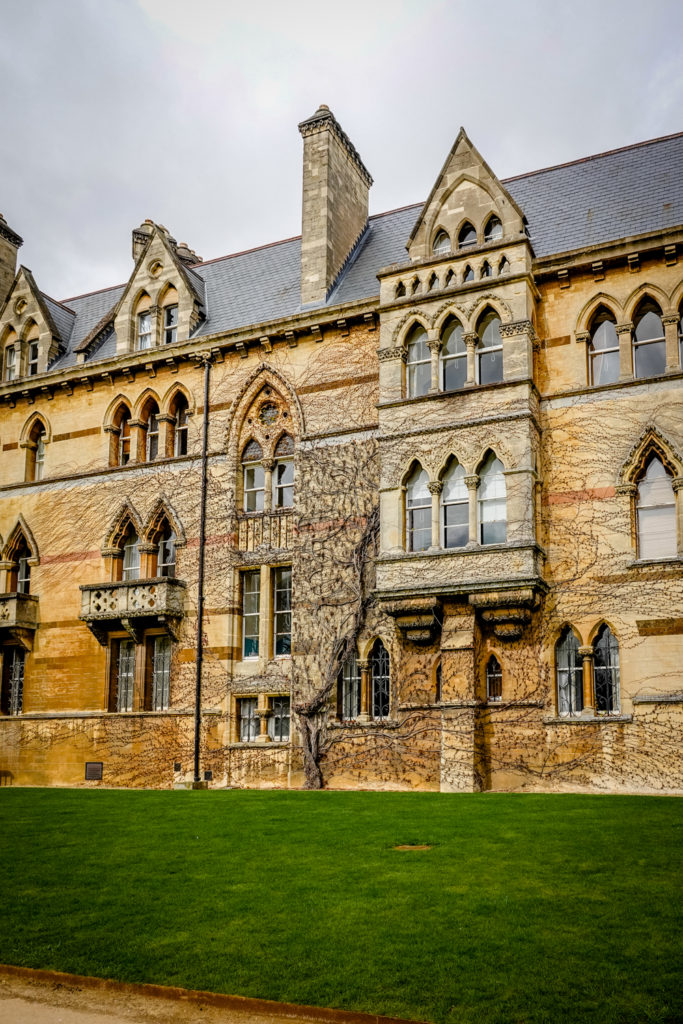





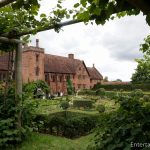


This is fascinating and your photos are beautiful Helen! I could look at castles and old buildings all day – so glad you got the chance to visit. How about that Alice in Wonderland window?! What fun! 🙂 Thanks for sharing that wonderful place – can’t wait to see it myself some day!
Alice looked a bit somber, didn’t you think? Not exactly the life of the party.
Wow, thank you for all the history—and the gorgeous photos. Though I am not a Harry Potter fan, I can certainly appreciate the architecture and history. Love the windows and we just don’t have much that old here in the US! Thanks again!
I didn’t realize the Harry Potter connection myself until I got there, and kind of stumbled on it. I feel like I’m always tripping over different connections while in England. There is indeed a LOT of history. The Brits take it for granted, but those of us from the other side of the pond are truly amazed.